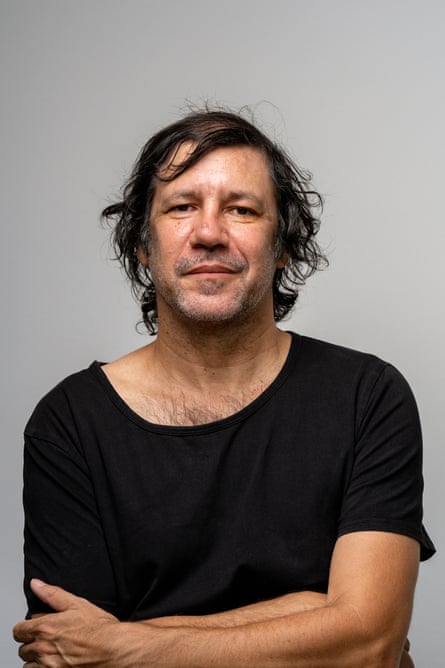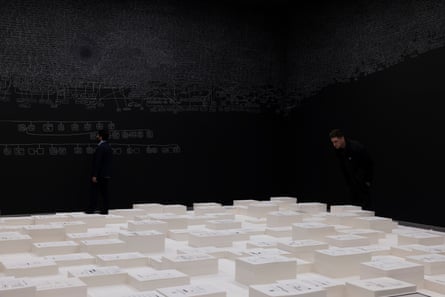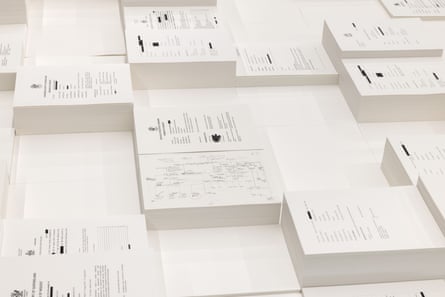For the past two months, in the quiet, darkened room of the Australia pavilion at the Venice Biennale, Bigambul-Kamilaroi artist Archie Moore has been drawing by hand in chalk a vast and meticulous genealogy.
But Moore’s work, kith and kin – Australia’s official entry in the 2024 Venice Biennale, which opened this week with the theme “Foreigners everywhere” – is about much more, and its grand scope reveals itself slowly.
Moore begins with his family tree. The chalk lines expand across and up the walls, back through time and space to encompass the thousands of generations that have gone before, and then they spill on to the ceiling where the ancestral names become like stars in an infinite night sky.
The work, kith and kin, is about 65,000 years of Aboriginal history and non-linear concepts of time and place. Moore, paraphrasing the anthropologist WE Stanner, calls it “the everywhen”.


“The past, present and future share the same space in the here and now,” Moore says. “Stanner said ‘one cannot fix the dreaming in time. It was, and is, everywhen’.”
Beneath this teeming mass of lives is a white table neatly stacked with the records of hundreds of Aboriginal deaths. Among them are the redacted coronial reports of the 557 Aboriginal people who have died in police and prison custody since the 1991 royal commission handed down 339 recommendations designed to stop those preventable deaths from occurring.
“It is as many coronial inquests that we could source through each of the different states and territories,” the curator of kith and kin, Ellie Buttrose, says. “Anything that couldn’t be found is represented with a blank document because making those gaps visible is really important to this project in multiple different ways.
“It’s about the tension between representation and abstraction. How do you represent these horrors? How do you do them justice? It’s very difficult with words or images, so the void plays an important role.”
The table sits within a pool of still water, serving as a shrine of remembrance and memorial for black lives lost to institutional violence and neglect. But the documents are hard to view.
“You have to lean across the water to glimpse them,” Buttrose says, “and you see your own reflection as you do. You become part of the work; you have to look at yourself in the context of all this loss.”
Moore and Buttrose have been working in the pavilion for about two months. It’s rare for artists exhibiting at the Biennale to spend such a long time in advance, Buttrose says. But the work had to be inscribed on to the space. The site has been empty for most of the time. Their small team has been working with just the birds for company and the occasional boat puttering down the Rio dei Giardini beyond the window.

Now, with the Biennale opening on Wednesday evening Australian time, there is noise and people and activity – foreigners everywhere. Days before the event, on the afternoon I go to meet Moore and Buttrose at the Australian pavilion, the Giardini is alive. There’s a dress rehearsal under way for the Altersea Opera, the Swedish-born Cantonese artist Lap See Lam’s exploration of migration and displacement, outside the Nordic pavilion. At the English and French pavilions, works are being trundled around, audio tested, gardens upgraded. Old trees have been removed and replaced in the time Moore has been here drawing kith and kin.
He says the work of drawing by hand in chalk has been at times physically taxing. And while it is ambitious, it is also understated. After stepping into the darkened space designed by the Kaurereg-Meriam architect Kevin O’Brien, it is not easy to see all at once. But then the names, like spirits, reveal themselves. Moore says that is deliberate; Aboriginal worldviews are subtle and easily overlooked.
The work speaks to our people’s relationships to each another, our ancestors and our country. But it is also a history lesson (hence the chalk) about life before and during the brutality of colonisation. In places, dozens of the fragile squares are smudged and indecipherable.
“They are disruptions to the information and genealogy. So it could be a massacre, it could be smallpox, it could be records being destroyed or not recorded in the first place,” Moore says.

In others, there is simply blank space, signifying the gaps in the archive, and the subsequent gaps in our own knowledge of our ancestors, the names they gave themselves and the humiliating descriptors they were burdened with by the colonisers.
The artwork is a result of a huge amount of research in libraries, newspapers, pastoral diaries, maps, archives, historical societies, Guardian Australia’s database Deaths Inside, state archives and discussions with family members.
“The phrase ‘kith and kin’ simply means friends and family these days,” Moore says. “But an old English definition from the 1300s shows kith to mean ‘countrymen’ and also ‘one’s native land’. That old English meaning feels more like the First Nations understanding of attachment to place, people and time.”
Art historian and critic Djon Mundine says he imagined Archie’s drawing as akin to “constructing an algebraic equation to solve an intangible, immeasurable problem”.

Mundine, writing in a catalogue essay, situates kith and kin among Aboriginal concepts of the sacred.
“Traditionally ‘God’ can appear in Aboriginal life as a flash of ‘white’ light or a refraction of light into the seven rainbow spectrum colours. Certain creatures display this refraction: the shedding skin of reptiles, wings of certain insects, shellfish, trees shedding their bark, and the scales of fish,” Mundine says.
“Archie meticulously drew row upon row of flat rectangular boxes in his family tree, that run down the wall like chanting names of dead people, as scallop-oyster beds, like fish scales, or a dripping broken honeycomb. Both metaphors (my own) are evocative of life, sex, regeneration, vitality, and potency. And very totemic and very Aboriginal.”
Moore says that, at its simplest, a family tree is universally understood.
“I’m just trying to give an impression of this huge amount of time and Aboriginal inhabitation on the continent. And I’m including everyone in the tree. If we go back 3,000 years, humanity all has a common ancestor. So it’s about the human global family tree as well.”
kith and kin opens at the Australia pavilion at the Venice Biennale on Wednesday at 6.45pm AEST (10.45am in Italy). You can watch the livestream on Instagram @austatvenice
A talk featuring Guardian Australia Indigenous affairs editor, Lorena Allam, will be livestreamed here on Thursday at 6pm AEST (10am in Italy)
Lorena Allam travelled to Venice courtesy of Creative Australia
https://news.google.com/rss/articles/CBMidGh0dHBzOi8vd3d3LnRoZWd1YXJkaWFuLmNvbS9hcnRhbmRkZXNpZ24vMjAyNC9hcHIvMTcvYXVzdHJhbGlhLXZlbmljZS1iaWVubmFsZS1mYW1pbHktdHJlZS1raXRoLWFuZC1raW4tYXJjaGllLW1vb3Jl0gF0aHR0cHM6Ly9hbXAudGhlZ3VhcmRpYW4uY29tL2FydGFuZGRlc2lnbi8yMDI0L2Fwci8xNy9hdXN0cmFsaWEtdmVuaWNlLWJpZW5uYWxlLWZhbWlseS10cmVlLWtpdGgtYW5kLWtpbi1hcmNoaWUtbW9vcmU?oc=5
2024-04-17 02:04:00Z
CBMidGh0dHBzOi8vd3d3LnRoZWd1YXJkaWFuLmNvbS9hcnRhbmRkZXNpZ24vMjAyNC9hcHIvMTcvYXVzdHJhbGlhLXZlbmljZS1iaWVubmFsZS1mYW1pbHktdHJlZS1raXRoLWFuZC1raW4tYXJjaGllLW1vb3Jl0gF0aHR0cHM6Ly9hbXAudGhlZ3VhcmRpYW4uY29tL2FydGFuZGRlc2lnbi8yMDI0L2Fwci8xNy9hdXN0cmFsaWEtdmVuaWNlLWJpZW5uYWxlLWZhbWlseS10cmVlLWtpdGgtYW5kLWtpbi1hcmNoaWUtbW9vcmU
Tidak ada komentar:
Posting Komentar